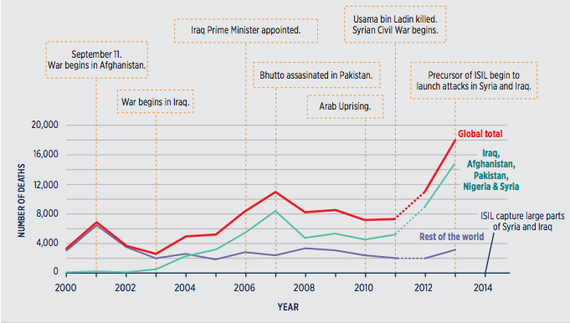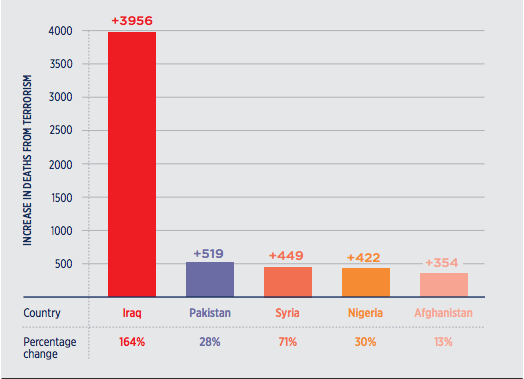
Institute for Economics and Peace
"Terror And The Other Religions"
Of the 17,958 people who died in terrorist attacks in 2013, 82 percent were in one of five countries: Iraq, Afghanistan, Pakistan, Nigeria, and Syria. That's one finding from this year's Global Terrorism Index report, published by the Institute for Economics and Peace. The report is based on data from the University of Maryland's Global Terrorism Database, which has information on more than 125,000 terrorist attacks between 1970 and 2013.
The report found a 61-percent jump in terrorism fatalities between 2012 and 2013. "Over the same period," the authors wrote, "the number of countries that experienced more than 50 [terrorism-related] deaths rose from 15 to 24"—an indication that the problem of terrorism was getting both more fatal and more widespread a year before ISIS declared a new caliphate.
But it's also striking where terrorism didn't occur. Much of the increase in terrorism-related fatalities in 2013 took place in Iraq, where terrorists claimed nearly 4,000 lives—a 168-percent increase over 2012. Worldwide, Iraq was the worst-affected country, accounting for 34 percent of terrorism-related fatalities in 2013, with Afghanistan ranked next with 17.3 percent. Meanwhile, between 2000 and 2013, the report found, around 5 percent of terrorism-related fatalities occurred in the 34 wealthy countries of the OECD. In 2013 specifically, there were 113 terrorism-related deaths in OECD countries—0.6 percent of the worldwide total. Six of these took place in the United States.
Deaths From Terrorism, 2000-2013

Percentage of Global Terrorism-Related Deaths, 2013

Biggest Increases in Terrorism-Related Deaths, 2012-2013

While last year's terrorism fatalities may have been concentrated in a small number of countries, the authors do note that overall, "Since 2000 there has been over a five-fold increase in the number of deaths from terrorism, rising from 3,361 in 2000 to 17,958 in 2013."
Much of that period corresponded with massive international military efforts to root out terrorism. And as the U.S. winds up its war in Afghanistan—a country that saw a 13-percent increase in terrorism-related fatalities last year—and considers the extent to which it wants to intervene militarily to halt the spread of ISIS, it's worth asking: How does terrorism actually end? The question is one that the Rand Corporation addressed in a 2008 study that the Global Terrorism Index authors cite. That report examined 268 terrorist groups that halted their attacks between 1968 and 2006. In only 7 percent of those cases, the report found, military intervention brought about the end of a terrorist group.

That finding suggests the debate over whether to put boots on the ground in Iraq and Syria—and whose boots, and how many, and whether they should be combat boots or just training-and-advisory boots—misses a larger point about the conditions that are most associated with terrorism. The report's authors devote the final section of the study to examining the factors that correlated with higher levels of terrorism in 2012-2013; among the most significant they found were ethnic and religious tensions, as well as levels of state repression including, for example, human-rights abuses and extrajudicial killings. "This can be viewed in two ways," the authors write. "Either increased terrorism leads governments to implement stricter, authoritarian and illegal acts toward its citizens through torture or state violence, or the repression results in terrorist acts as retaliation. This can create a vicious cycle of violence making it difficult to clearly identify causality."
These correlations also speak to the relationship between terrorism and conflict more broadly. "The most common context for the onset of terrorist violence is within an ongoing conflict," the authors write. About 70 percent of the fatal terrorist attacks recorded in the Global Terrorism Database between 1970 and 2013 took place in countries with serious ongoing conflicts.
This point—that war breeds violence—is not particularly novel or satisfying. But the fact that Afghanistan and Iraq continue to top the list of countries most affected by terrorism does highlight the limitations of foreign military intervention in ending terrorist violence. And warnings about threats to the homeland notwithstanding, it's not primarily Americans who suffer for it.
No comments:
Post a Comment